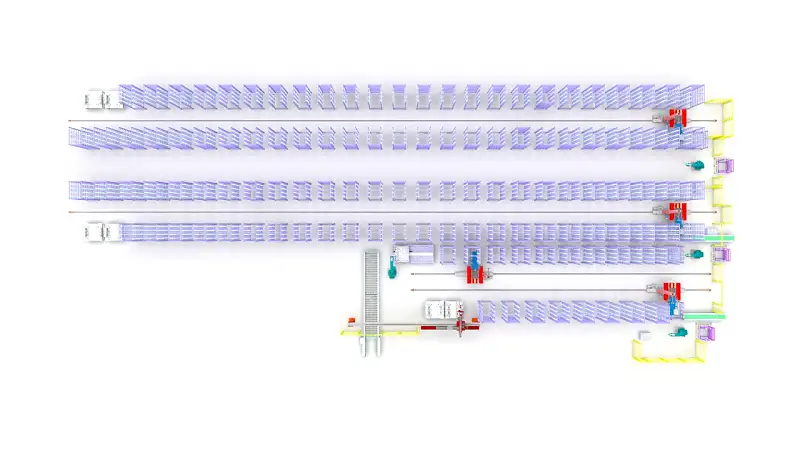With the rapid development of the logistics industry and the increasing complexity of supply chains, vertical warehouses have become a crucial facility for efficient storage and distribution. However, safety management and risk control in vertical warehouses are of utmost importance. This article will focus on discussing the safety management strategies and risk control measures in vertical warehouses, ensuring safe operations and the personal safety of employees.
I. Safety Management Strategies
1. Cultivating a Safety Culture: Establishing and fostering a strong safety culture is the primary step in ensuring safety management in vertical warehouses. Warehouse enterprises should develop safety policies and standards, and communicate them to all employees, ensuring that each individual has a clear understanding of the importance of safety awareness. Additionally, regular safety training and drills should be organized to enhance employees’ emergency response capabilities and safety awareness.
2. Equipment Safety Management: The safety of equipment in vertical warehouses forms the foundation of warehouse safety. Enterprises should ensure the compliance and stability of equipment, conduct regular maintenance and inspections to guarantee proper equipment operation. Furthermore, equipment should be classified and managed accordingly, with standardized operating procedures in place to strictly prohibit unauthorized operations and modifications of equipment parameters to prevent potential safety hazards.
3. Safety Monitoring and Warning Systems: Establishing a comprehensive safety monitoring and warning system is crucial for timely detection and response to potential safety threats. Warehouse enterprises should install high-definition surveillance equipment, covering key areas inside and outside the warehouse, to monitor real-time operations. Additionally, an alarm mechanism should be implemented to promptly alert and address emergencies, ensuring the personal safety of employees and the integrity of warehouse equipment.
II. Risk Control Measures
1. Fire Risk Control: Vertical warehouses, storing a large volume of materials, present severe consequences in the event of a fire. Warehouse enterprises should conduct fire risk assessments and establish firefighting facilities and evacuation routes. Regular inspections and maintenance of fire safety equipment should also be carried out. Furthermore, employee fire prevention and control training should be strengthened to enhance their self-rescue and evacuation capabilities during fire emergencies.
2. Material Stacking Risk Control: The stacking of materials in vertical warehouses may pose risks such as collapsing and toppling. Warehouse enterprises should establish proper stacking standards and operating procedures, ensuring the stability and safe stacking of materials. Regular inspections should be conducted to identify and address any issues promptly, while adding necessary support and protective measures.
3. Personal Safety Risk Control: Vertical warehouses present complex operational environments, with employees exposed to risks such as falls and collisions. Warehouse enterprises should provide personal protective equipment to employees and offer safety training, emphasizing precautions and safety operating procedures. Prohibiting unauthorized operations and improper access to elevated areas can reduce the impact of human factors on safety.
III. Emergency Response and Management
1. Development of Emergency Plans: Comprehensive emergency plans should be established for vertical warehouses, including plans for fire incidents, accidents, and other emergencies. These plans should clearly outline emergency measures and assign responsibilities for various scenarios. Regular drills and evaluations should be conducted to ensure all departments and employees are familiar with and proficient in their emergency duties.
2. Material Reserves and Emergency Facilities: Warehouses should stock necessary firefighting equipment, first aid facilities, and emergency supplies to address unforeseen events. Emergency facilities should be strategically placed and clearly labeled to enable employees to quickly locate and utilize them during emergencies.
3. Risk Assessment and Improvement: Warehouse enterprises should conduct regular safety risk assessments and inspections to identify potential safety hazards and take immediate actions for improvement. Incident investigations and case studies should be carried out promptly to identify lessons learned and continuously improve safety management measures, enhancing the overall safety level of the warehouse.
Safety management andrisk control in vertical warehouses are vital measures to ensure safe operations and protect the personal safety of employees. Warehouse enterprises should implement effective safety management strategies, including cultivating a safety culture, equipment safety management, and establishing safety monitoring and warning systems. Additionally, they should adopt risk control measures such as fire risk control, material stacking risk control, and personal safety risk control. Furthermore, proper emergency response and management, including the development of emergency plans, material reserves, and continuous risk assessments, are essential components of safety management in vertical warehouses. By implementing these measures, vertical warehouses can operate safely and efficiently, contributing to the continuous growth of the logistics industry.

